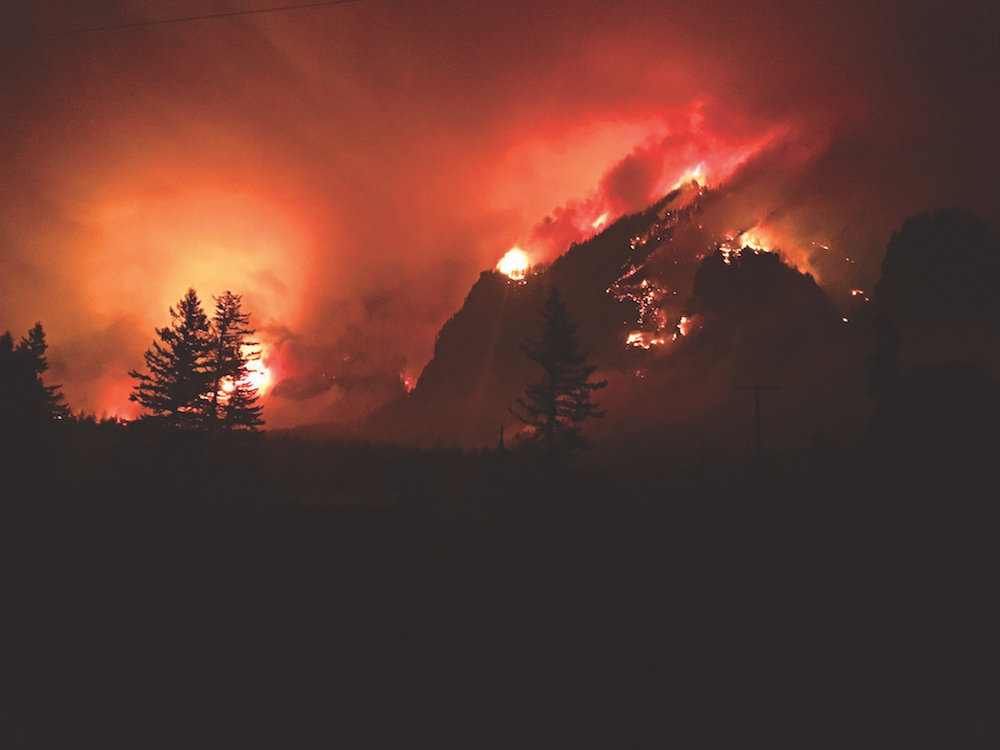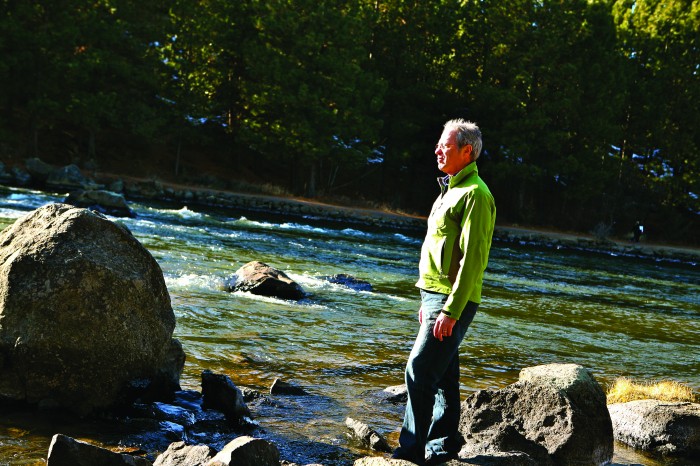Will the 2017 wildfire season change the way Oregonians fight fire?
written by Sophia McDonald
It’s common for people to remember exactly where they were and what they were doing when they received the news of the wildfire. Kevin Gorman is no different. On September 2, 2017, the executive director of Friends of the Columbia Gorge was at his Portland-area home enjoying a relaxing Memorial Day weekend. That came to an abrupt end mid-afternoon.
“A friend of mine texted me a picture from Multnomah Falls with plume of smoke and said, ‘Do you know about this?’” he recalled. “It was within about twenty minutes of it starting, so I didn’t.”
Gorman hopped online just in time to see the first news of the Eagle Creek Fire. He was glued to his computer for the rest of the weekend, and he wasn’t the only one. Millions of people across Oregon watched in horror as parts of their beloved Columbia River Gorge succumbed to what seemed like a particularly horrendous wildfire season. Between the thick smoke that covered the state’s most populated areas and the air quality alerts that were issued with alarming frequency, it was easy to feel as if a kind of apocalypse was coming, or that the state’s signature pine forests might never recover from the devastation wrought by the flames.
Eight months later, with the fires out and rain still falling from alternately blue and gray skies, it’s easier to take a more nuanced view of what happened. In some ways, the 2017 wildfire season wasn’t actually that bad. The state had 2,042 fires in 2017, which is lower than the ten-year average of approximately 2,400. Those fires, however, burned nearly 665,000 acres, about a third more than normal. Several of the fires were not completely extinguished until November, which means they also lasted longer. Experts consider it the fifth-worst fire season of the century.
Hope is not lost for Oregon’s forest—not by a long shot. Sean Stevens, executive director of the Portland-based environmental organization Oregon Wild, points out that fire is a natural part of the forest ecosystem. “We have this innate sense of being scared of it,” he said. “It’s hard to wrap our heads around that, that it can be beneficial. But the forests that we know are a product of fire.
“Certainly climate change is having an impact on our fire seasons,” he added. “What the science is showing us is we’re having longer fire seasons because we have longer periods of heat and drought. But in the overall scope of fire of Oregon, we’re in a fire deficit as compared to historical norms because we try to put so many fires out.”
Stevens also reassures people that the forests are still there. “In a place like the Gorge, you’re especially going to see this because it’s a protected area,” he said. In areas where the effects of fire are more noticeable, “the forests may look different to us, but they’re not destroyed.”
This year is expected to bring plenty more fire and smoke to the state. The flip side of a relatively dry and outdoor adventure-friendly winter and spring is that drought conditions are quite likely, particularly in Southern and Eastern Oregon. “My gut is telling me it may be a slightly above-average fire season coming up,” said Dave Larson, district forester for the southwestern district of the Oregon Department of Forestry (ODF), as he sat behind a desk in his Medford office.
The question, then, is whether Oregonians’ response will be any different than in previous years. With Wildfire Awareness Month activities underway in the month of May, and state agencies and private contractors preparing for the start of fire season, it’s a question that’s very much on people’s minds.
One of the long-running debates about lessening the impact of forest fires revolves around how federal lands are managed. Advocates for more active forest management would like to see professionals out in forests removing brush, small trees and the lower limbs on big trees, which are known as ladder fuels because they allow fires to scale up trunks and set canopies ablaze. This vegetation is a principle reason wildfires are burning hotter and doing more damage.
“Out of the almost 700,000 acres that were burned [last summer], nearly 95 percent of those fires were on federal land, not on state or private land,” said Jim Geisinger, executive vice president of Associated Oregon Loggers. “It’s because we have excessive fuels on our federal lands because we haven’t been managing them for the last twenty years. You’re not going to prevent fires, but the way you keep them from being so intense and so large is to manage the landscape so that when fire does happen, it doesn’t turn into a catastrophic situation.”
The lack of management is linked to disappearing funding for fire suppression efforts. Geisinger refers to this as the “fire borrowing” problem. Congress appropriates money to the U.S. Forest Service to fight fires, but in bad wildfire seasons it’s quickly depleted. Like a parent raiding their kids’ college fund during hard economic times, lawmakers must pull funds from other sources to pay for firefighting efforts. They’ve commonly used the money set aside for suppression.
The Congressional Resilient Federal Forests Act of 2017 (which is cosponsored by Rep. Greg Walden) aims to change that. “That bill would do two things,” Geisinger said. “It would change the way fire suppression is funded, and it would give the Forest Service the direction and authority and tools to reenact forest management as part of their prevention program.” The U.S. House has already approved the bill. When or whether it will pass the persnickety Senate is anyone’s guess. Stevens, however, describes the bill as a major threat to Oregon’s forests because it would alter or change enforcement of a number of laws designed to protect natural spaces, including the Endangered Species Act, Roadless Area Conservation Rule and Northwest Forest Plan.
Another debate revolves around what to do with forests after they’ve burned. As soon as it’s safe, ODF officials are out on their lands assessing the damage. They cut down trees that could fall and injure people and identify places where logs can be salvaged. “It’s time sensitive after you have a fire go through,” Larson said. “Within weeks, the bugs start moving in and the decay of the timber starts setting in.” Reforestation begins quickly after harvest.
Federal lands, on the other hand, are strictly governed by forest management plans that prevent these activities. There’s a reason for that, Stevens said. “If we’re concerned with having a diverse natural forest, we don’t want to go in and plant. Nature is going to do a great job of replenishing the native species.”
Geisinger pushed back on that perspective. “The difference is Mother Nature will take 300 years to restore that forest,” he said. “With a little help from man it can be restored in ten or fifteen years.
“All the polls we’ve done say Oregonians like to see their forests green, not black,” he added.
Though the Forest Service is usually allowed to remove dead trees that present a public safety threat, “it’s more complex with full-scale salvages,” Larson said. “There’s a notification process and public comment period.” Environmental groups often file lawsuits to block salvage operations, which means the de facto approach is still “hands off.”
What happens on federal lands is important. “The problematic part is the landscapes don’t recognize jurisdiction or wilderness boundaries,” said Mike Robison, district manager of the Coos Forest Protective Association. But even if Congress passes something like the Resilient Federal Forests Act, it will take time for that legislation to be enacted.
“There are millions of acres of lands that need to have this prescribed action taken on them to make them more resilient,” Robison pointed out.
Forest maintenance is part of creating resilient landscapes, but there’s also a lot to be said for maintaining the state’s native and old-growth forests and keeping wilderness areas wild. The latter point is driven home by Gorman with Friends of the Columbia Gorge.
“The amazing thing to think about is that on the 48,000 acres that burned [during the Eagle Creek Fire], four buildings burned and there was no loss of human life,” he said. “That’s it. The firefighters were able to focus on the communities that were there and the historic structures like Multnomah Falls Lodge, and allow some of the fire to burn because there was no human health threat. If the scenic area had not been in place and we had cabins throughout that area, we would have had to do disbursed firefighting to fight these fires, and we would have had more property loss and human loss.”
Stevens would like to see the state shift some of its firefighting resources to Firewise training, which helps communities adapt to living with wildfires. Steps include creating defensible space around homes, cleaning pine needles and debris from roofs and gutters, and creating city-wide fire response strategies in partnership with first responders. “The data really backs it up that it’s not the severity of the fire, it’s how prepared you are,” he said. “There are some pretty simple things people can do if they live in a fire-prone area to be prepared.”
It would be easier to fight wildfires during the busy summer season if they were reported earlier. To help with that, Geisinger advocates for having more loggers out in forests. They can also serve as first responders to fires, he pointed out, and creating more timber jobs would be a boon to rural communities struggling to create family-wage jobs.
Robison hopes to eventually be allowed to do more prescribed burns. “We need to add fire at the right times, not in the middle of the summer,” he said. “It would help with landscape resilience if we could apply fire for a week or two early in the year.”
But until Oregonians learn to live with the hazy air that comes with those prescribed burns, he and his colleagues will have to settle for improving their responsiveness to wildfires. In that regard, Larson sees a small silver lining from 2017. “Each time we have a busy season, I think we get better at handling fires,” he said. “It helps us build relationships with our communities and our landowners and build that system of fire management.”
Gorman sees positive changes coming from 2017 as well. Portions of the historic highway that leads to Multnomah Falls was damaged in the Eagle Creek Fire. Before it reopens, the Oregon Department of Transportation is looking for better ways to manage congestion around the recreational site.
Friends of the Columbia Gorge has talked for years about creating a system of trails that travels through the whole scenic area. “Now that the fire has happened and some of those lands should be given time to heal, we’re starting to move forward on that vision and create a sustainable recreation system that will last into the next century,” he said. More than 4,000 people have signed up to build new trails or rehabilitate existing ones.
“Everyone has a passion for the Gorge, but it’s so easy to take these areas we love for granted,” he said. “I think no one is taking the Gorge for
granted anymore.”









